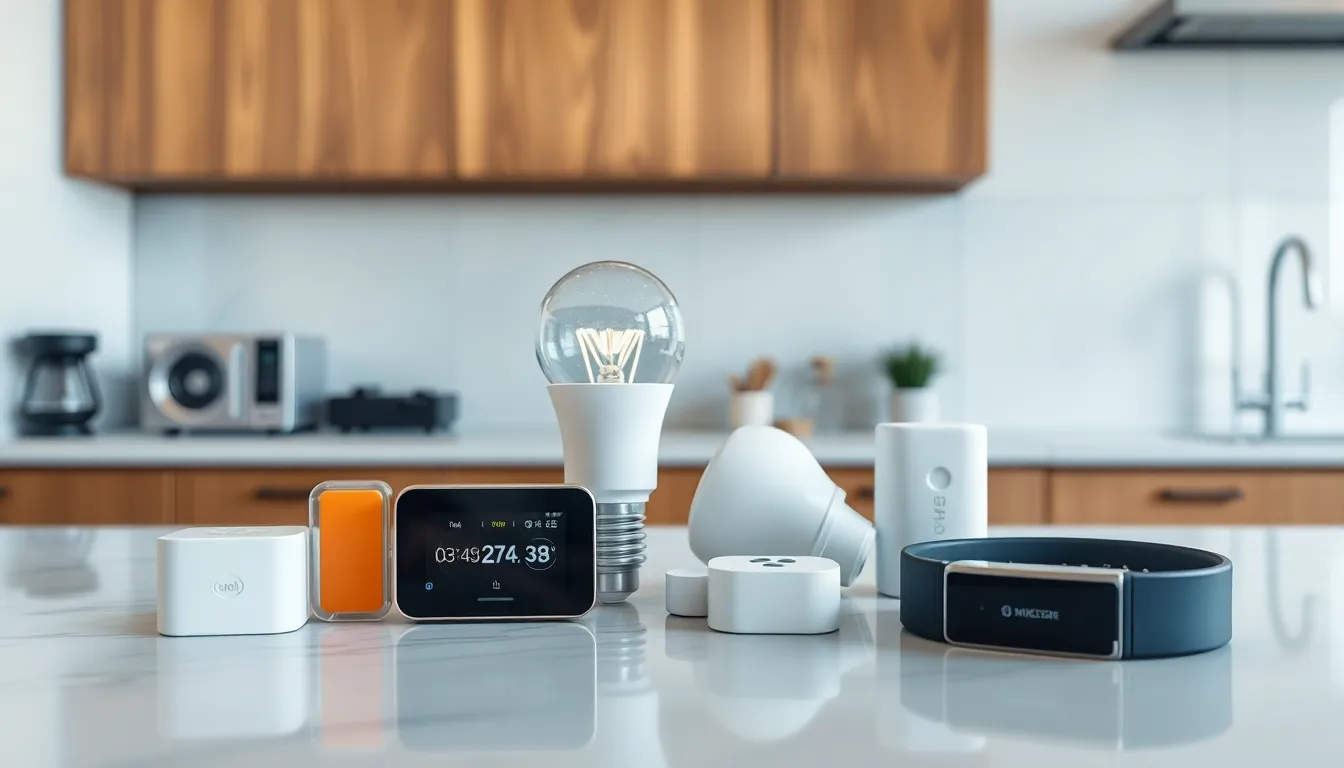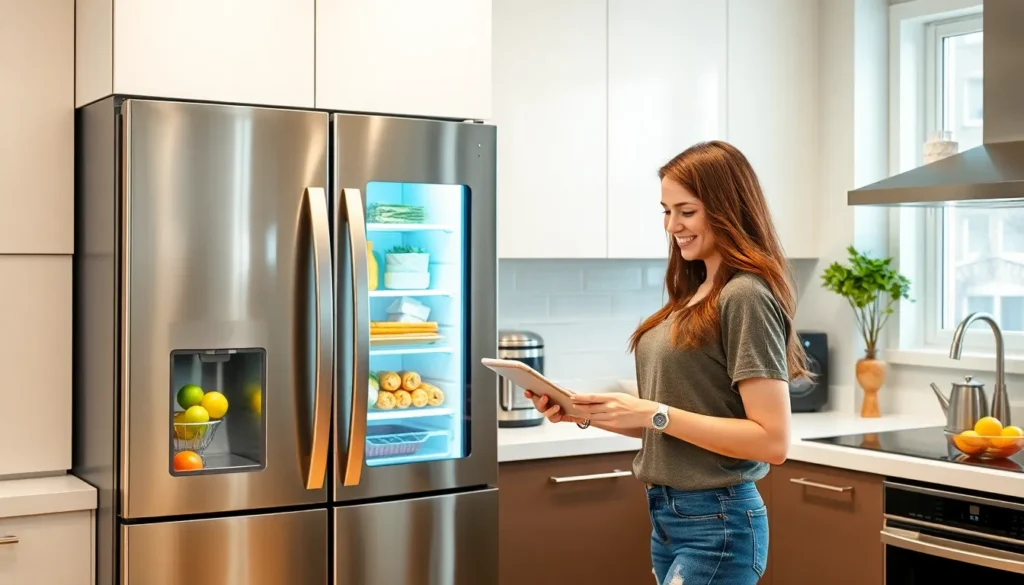Table of Contents
ToggleImagine a world where your toaster knows exactly how brown you like your bread and your fridge can remind you when you’re running low on milk. Welcome to the Internet of Things (IoT), where everyday objects are getting smarter and more connected. It’s like your appliances went to college and graduated with honors in communication.
In this digital playground, everything from your coffee maker to your car can share data and interact, making life easier and a tad more entertaining. With IoT, you can control your home from your smartphone, and let’s be honest, who wouldn’t want to turn off the lights without getting off the couch? Dive into the fascinating realm of IoT and discover how these interconnected devices are reshaping our lives, one quirky gadget at a time.
What Is the Internet of Things
The Internet of Things (IoT) refers to a network of everyday objects interconnected through the internet. Each device, from smart home appliances to wearable technology, communicates and shares data. This connectivity allows them to operate autonomously or be controlled remotely.
Smart appliances illustrate how IoT simplifies daily routines. For instance, a smart fridge can monitor food freshness and send alerts when supplies run low. Similarly, a thermostat learns user preferences, optimizing energy consumption.
Data generated by these devices enhances user convenience and decision-making. Users gain insights into their habits, leading to more efficient household management. Companies leverage this data to create smart products tailored to consumer needs.
Security remains crucial as IoT devices proliferate. Vulnerable devices can provide entry points for cyber threats. Manufacturers prioritize building secure systems, including regular updates and data encryption.
The potential of IoT extends beyond homes. In agriculture, sensors monitor soil moisture and crop health, maximizing yield. Transportation systems enhance efficiency with real-time traffic updates. Cities can implement smart infrastructures, improving public services.
Emerging technologies like artificial intelligence and machine learning further amplify IoT capabilities. These technologies enable predictive analytics, allowing devices to anticipate user needs. As IoT continues to evolve, it transforms how people interact with their environment and each other.
Key Components of IoT

The Internet of Things (IoT) consists of various essential components that work together to create a seamlessly connected ecosystem. Each component plays a crucial role in enabling devices to communicate and operate effectively.
Sensors and Devices
Sensors and devices form the backbone of IoT systems. These components collect data from the environment, such as temperature, humidity, and motion. Smart appliances, including thermostats, light bulbs, and wearable devices, use sensors to monitor conditions and gather user data. The integration of these sensors enables real-time responses based on environmental changes, enhancing user experience. Manufacturers continually innovate in sensor technology, leading to more accurate and efficient devices.
Connectivity
Connectivity is integral to the IoT framework. Devices rely on wireless technologies, such as Wi-Fi, Bluetooth, Zigbee, and cellular networks, to communicate with each other and the cloud. Each technology serves specific needs, balancing range, power consumption, and data transfer rates. Reliable connectivity ensures seamless data exchange between devices and applications, enabling remote access and control. As connectivity solutions advance, they enhance the overall performance and scalability of IoT systems.
Data Processing
Data processing drives the intelligence behind IoT devices. Collected data undergoes analysis to generate actionable insights. Cloud computing and edge computing serve as key platforms for data processing, allowing for real-time analysis and storage. Machine learning algorithms play a significant role in transforming raw data into useful information. This data-driven approach enables organizations to make informed decisions and optimize operations effectively, reinforcing the impact of IoT across various sectors.
Applications of IoT
The Internet of Things (IoT) has numerous applications that enhance efficiency and improve quality of life across various domains. Below are some notable areas where IoT plays a significant role.
Smart Homes
Smart homes utilize connected devices to automate tasks and improve energy efficiency. Homeowners control lighting and appliances remotely through smartphones, providing convenience and security. Smart thermostats learn user preferences to optimize heating and cooling schedules, while smart locks enhance home security through remote access. Energy-monitoring systems track consumption patterns, helping residents make informed decisions about usage and cost savings. Overall, smart homes contribute to a more comfortable and efficient living environment.
Industrial IoT
Industrial IoT transforms manufacturing and supply chain management with real-time data and connectivity. Sensors monitor equipment health, enabling predictive maintenance to minimize downtime and reduce costs. These devices collect and analyze data, allowing manufacturers to streamline operations and enhance productivity. Companies leverage this data for better resource allocation and inventory management, leading to increased efficiency. Automation in the industrial sector drives innovation and competitiveness, ultimately evolving traditional practices into more agile processes.
Healthcare
IoT revolutionizes healthcare by enabling remote patient monitoring and efficient data collection. Wearable devices track vital signs, providing healthcare professionals with continuous insights into patients’ conditions. Telemedicine solutions connected through IoT facilitate virtual consultations, improving access to care for patients in remote areas. Medical devices send real-time alerts of abnormalities, allowing timely interventions that can save lives. Overall, IoT enhances patient outcomes and optimizes healthcare delivery systems through data-driven insights.
Benefits and Challenges of IoT
The Internet of Things offers numerous benefits while presenting some challenges. Understanding both aspects leads to more informed decisions regarding IoT implementation.
Benefits
IoT enhances convenience across daily tasks. Connected devices allow users to access and control home appliances remotely. Automation features reduce energy consumption, contributing to sustainable living. Data-driven insights improve efficiency in various sectors such as healthcare and agriculture. Smart agriculture promotes optimized resource usage and increased crop yields. In industry, IoT enables predictive maintenance that minimizes downtime. Overall, IoT revolutionizes interactions with technology, leading to improved quality of life.
Challenges
Security concerns represent a significant challenge for IoT adoption. Increased device connectivity heightens vulnerability to cyber attacks. Privacy issues arise from the vast amount of data collected by connected devices. Regulatory compliance can become complex in various sectors, adding to the challenge. Additionally, differing standards hinder interoperability among devices, complicating integration efforts. Manufacturers need to prioritize secure design practices to mitigate risks effectively. These combined challenges necessitate careful consideration in IoT deployment.
Future of the Internet of Things
Growth in the Internet of Things (IoT) promises an increasingly integrated world where everyday devices enhance user experiences. Industry experts predict the number of connected devices could reach over 30 billion by 2030, enabling seamless interaction among them. Smart homes will evolve into interconnected ecosystems, where appliances not only respond to commands but also communicate with each other, optimizing energy use and improving overall functionality.
Healthcare innovations spurred by IoT will reshape patient care. Remote monitoring devices will provide real-time health data, leading to proactive interventions. As a result, medical professionals can deliver personalized treatment plans, increasing the effectiveness of care.
Agriculture stands to benefit significantly from IoT, implementing smart farming techniques. Sensors and devices will monitor soil conditions and crop health, allowing farmers to make informed decisions. Increased agricultural efficiency can lead to enhanced food production and reduced environmental impact.
Urban infrastructure will also undergo transformation, with smart cities emerging as a key focus area. IoT technologies will manage traffic flow, monitor air quality, and optimize resource distribution, making cities more sustainable and livable. Enhanced connectivity will facilitate data-driven decision-making, improving public services and safety.
Addressing security concerns is essential as IoT expands. Manufacturers must implement robust security protocols to protect sensitive data from cyber threats. Collaboration among industry stakeholders will foster the development of standardized practices, ensuring a secure IoT ecosystem.
Beyond security, interoperability remains a challenge. Devices from various manufacturers need to work together seamlessly, promoting user convenience. Efforts are underway to create universal standards that facilitate communication across different platforms, enhancing the overall functionality of IoT devices.
The Internet of Things is reshaping how people interact with their environment and each other. As more devices become interconnected the potential for enhanced convenience and efficiency grows. Smart homes and industries are just the beginning of IoT’s transformative journey.
While the benefits are significant the challenges of security and privacy cannot be overlooked. It’s crucial for manufacturers and users alike to prioritize secure practices and stay informed about emerging technologies.
Looking ahead the integration of IoT into daily life promises a future where technology seamlessly supports everyday activities. Embracing this change will lead to a more connected and innovative world.







